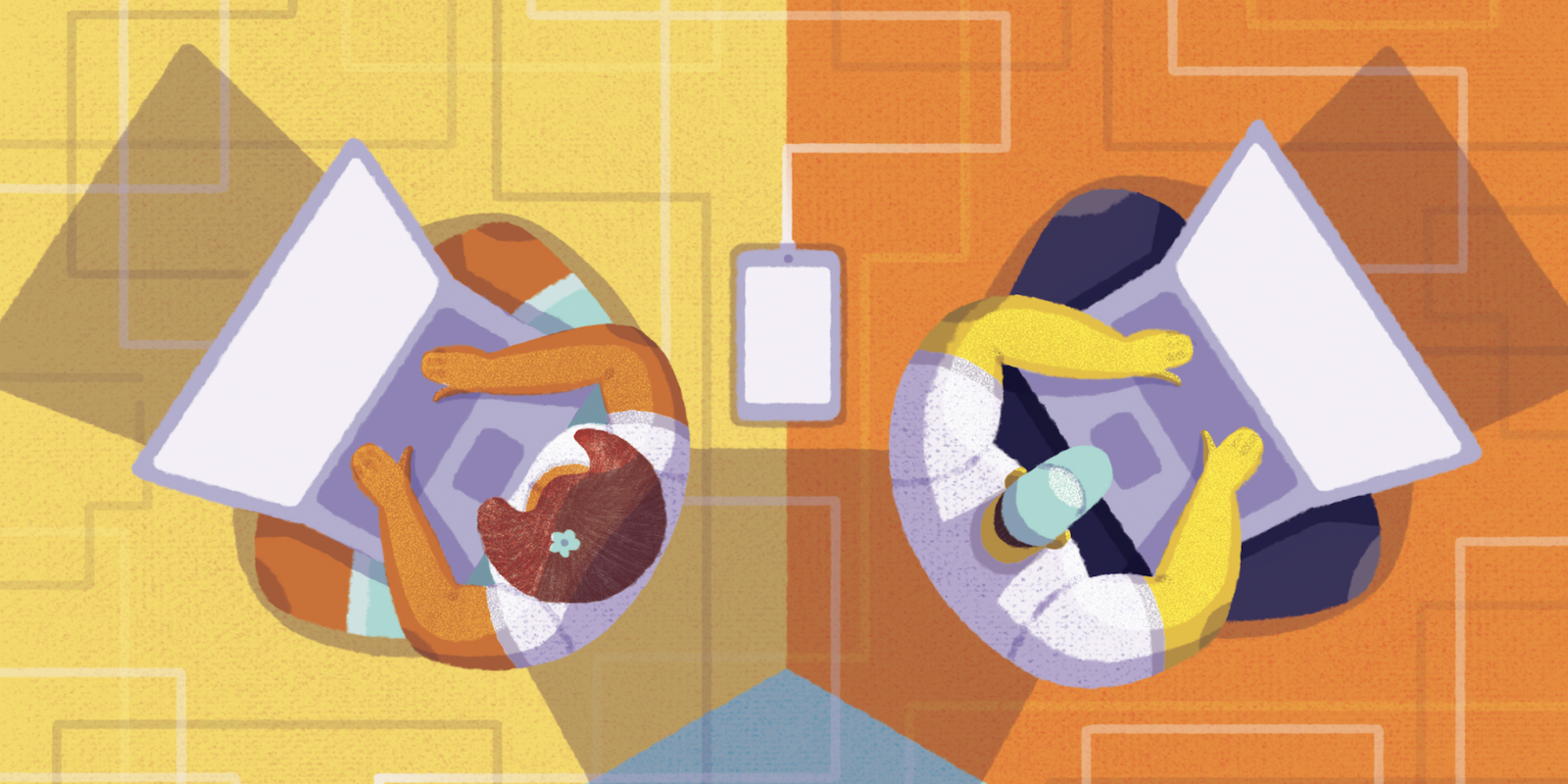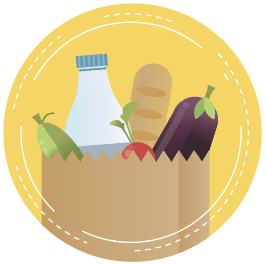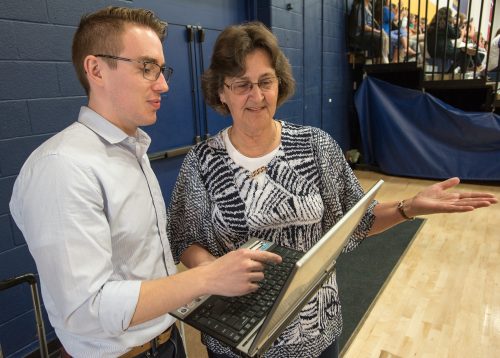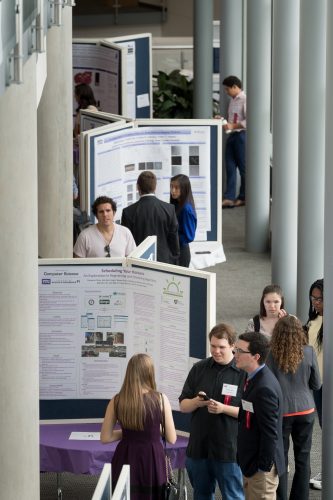

Computer Science Students Design Apps in Class
Capstone projects give teams chance to use software design skills to help clients improve services.
Laptop screens blazed against a backdrop of coffee cups, gnawed pen caps and backpacks strewn around adjacent labs on the third floor of the Tucker Technology Center just weeks into the Spring 2017 semester.
Like decades of computer science and computer information technology majors before them, the assembled students were focused on their senior design projects.
The capstone class, which dates to the mid-1980s, offers a real-world experience embedded in an academic setting. Beyond writing code, analyzing data and troubleshooting problems, three teams of students worked for clients. The two-course computer science sequence, which begins with a software engineering class in the fall semester, requires students to develop software applications.
During the capstone course’s existence, team projects have ranged from an app that turns a smartphone into a hearing aid to a national database to combat human trafficking. Students are in charge of their design work with clients. Each team must divide project duties and tasks among members.
“The senior design project was a perfect mirror of what it’s like to work in software development for a company,” said Matthew Ratliff ’15, a lead developer for Qualbe Marketing Group in Haltom City, a Fort Worth suburb. During his senior year at TCU, Ratliff worked on a project for Chalkbucket Labs that involved scoring and tracking data for CrossFit athletes and coaches.
“At my job now, my team and I frequently talk about how writing code is the easiest thing we do,” Ratliff said. “Interacting with our clients and understanding what they really want is the real work.”
Bryan Kribbs ’15, Ratliff’s senior project teammate, viewed the capstone course as relevant to his professional life. “The experience translated perfectly in terms of handling group decisions like delegating tasks,” said the Austin-based IBM software engineer. “It was by far the most beneficial part of my whole education.”
“Developing our solution from concept to working prototype in a team was very challenging compared to the small homework projects and exams we were used to as students,” said Jasmine Jernigan ’08, a San Francisco-based Google software engineer on the Gmail team.
At TCU, Jernigan’s senior project team designed a GPS-enabled mapping app for an early Windows smartphone. “The project gave me the practical experience to prepare me for real-life software engineering.”
Jernigan also credits Donnell Payne, associate professor of computer science, who oversees the capstone design course, with “pushing us to take on new technologies.”
Dealing with Deadlines
As each fall semester opens, Payne pitches projects to her senior design students and then arranges them into teams according to their strengths, interests and personalities.
“One year we decided to have a single, huge team, and by the end it was like World War III had broken out,” Payne recalled. “The senior design project is an intentionally intense experience, and over the years we’ve learned that groups of four or five students work best.”
For the 2016-17 academic year, Payne assigned 14 students to projects for three distinct entities: Meals on Wheels in Fort Worth, a small college’s conference for girls and TCU’s College of Science & Engineering.
“At some points in the winter, the students were butting heads with us because they wanted to change everything, and we didn’t,” said Liran Ma, associate professor of computer science, who served as the client for a redesign of a website for a college student research symposium at TCU. “They didn’t like me at the time, but they worked through it, and their finished product was really good.”
“At my job now, my team and I frequently talk about how writing code is the easiest thing we do. Interacting with our clients and understanding what they really want is the real work.”
Matthew Ratliff ’15
Troubleshooting scope-of-work challenges with real-world clients represents an essential aspect of the senior project experience. Payne hoped the on-the-job struggles spurred new insights and perspectives for the students regarding everything from accountability to perseverance.
“This is a very different beast than anything else at TCU,” said Will Taylor ’17, who worked on the project team that created a website for the local conference for girls. “The stakes were a lot higher, and our group felt a lot of ownership, especially when things weren’t going well.”
James Stewart ’17, who worked on the project team that redesigned the research symposium website, said: “As cliché as it sounds, we found out that deadlines come a lot faster than you think and that working face-to-face is better every time.”
Added Kathryn Jaslikowski ’17, who worked on the project team for Meals on Wheels: “Whenever we had a glitch or a problem with communication, we were forced to work hard to figure it out. But in our case, we also got great feedback from our client, and what we created has the potential to help people all over the country, which is something most seniors in college don’t have a chance to do.”
Meals On Wheels
 With teammates Nick Bomm ’17, Phil Howell and Wills Ward ’17, Kathryn Jaslikowski designed a web app for Meals on Wheels of Tarrant County. The Fort Worth nonprofit is the largest of the 5,000 independent and local Meals on Wheels programs in the U.S., according to Meals on Wheels of America.
With teammates Nick Bomm ’17, Phil Howell and Wills Ward ’17, Kathryn Jaslikowski designed a web app for Meals on Wheels of Tarrant County. The Fort Worth nonprofit is the largest of the 5,000 independent and local Meals on Wheels programs in the U.S., according to Meals on Wheels of America.
The agency serves a diverse population with a variety of needs, from mental and physical health issues to poverty and malnutrition. Meals on Wheels of Tarrant County serves nearly 1 million meals each year to a clientele with an average age of 75 and a median monthly income of $1,000, according to the nonprofit’s records.
“At one point, I had an 83-year-old client with a 60-something-year-old son who could only visit her about once a month, which was a situation I saw again and again,” said Samantha Powell, assistant professor of professional practice in nutritional sciences, who spent six years working for the organization. “Meals on Wheels delivered 10 meals a week to this woman, but filling the gap of those other 11 weekly meals was a significant and ongoing problem.”
Powell pitched the app project to Payne and then recruited two dozen nutrition students to develop and test recipes. The easy-to-make meals that Powell’s students created became accessible to the Meals on Wheels clientele thanks to the technology work of Jaslikowski and the rest of her senior design team.
“What we needed was a way to adapt to an individual’s limitations like allergies to certain foods or if they couldn’t use a can opener or if they could only get to certain stores within walking distance,” Powell said. “What we needed was a way to take all of these different variables and parameters, and then harness the latest in technology to serve these vulnerable people.”
With Powell explaining what the app needed to do, the assigned project team designed a portable and user-friendly web application called EasyBites.
“We wanted something that took the effort out of the dietitians’ visits with the clients, which was an idea that sounded great in the concept stage but wasn’t all that easy to apply,” Jaslikowski said.
The students’ ideas resonated with the nonprofit’s leaders with whom they met every other week. EasyBites so impressed the Fort Worth administrators that they tapped the students to present the web app at the group’s annual statewide conference in mid-April.

Kathryn Jaslikowski ’17 explains features of the EasyBites app in a roundtable discussion at the Texas conference of Meals on Wheels administrators. She took the participants through the profile of “Sally Soup” to show how food allergy and other information can be easily accessed. Photo by Leo Wesson
At the conference, Jaslikowski and her teammates demonstrated the app’s potential, using faux client profiles. For instance, Sally Soup suffered from allergies to nuts, gluten and dairy — essential information that was saved to her profile via a series of drop-down boxes. On another page, the team noted that Sally Soup had the ability to use both a slow cooker and knives. She also had access to a nearby grocery store.
“Site administrators can add stores or subtract them depending on client preferences,” Nick Bomm said, explaining the team’s app design. “If a client shops at Dollar General and there’s no soy milk available in that store, no recipes requiring soy milk will be included.”
With Sally Soup’s profile updated, EasyBites generated recipes along with their nutritional breakdown, using data from the USDA. Cost estimates for each recipe and approximate prep time accompanied each dish, too. Yet another keystroke produced a shopping list.
Sally Soup’s meal choices included barbecue beef surprise, lemon-pepper salmon and teriyaki chicken. The per-serving cost averaged $2.93. “That price is based on buyable quantities,” Ward said. “The client may use half a box of pasta but would still need to purchase a whole box at the store, so they may have leftovers. Or they might have something in their pantry already, which would also lower the projected price.”
Not only did Texas delegates at the Meals on Wheels conference embrace the web app, but EasyBites also garnered interest on the national stage. In May, the students reported that Meals on Wheels of America had expressed interest in offering the program to its members.
“EasyBites is a mobile solution to supplement meals that also fights social isolation and food insecurity,” said design team member Phil Howell, who also works as a lead client/server administrator at TCU. “My mom volunteered for two decades with Meals on Wheels, and I would do ride-alongs with her in Dallas as a kid. I have seen firsthand what a difference these meals can make.”
Expanding Your Horizons Conference
 Each spring, hundreds of junior high school girls descend on Texas Wesleyan University in Fort Worth for a day of enrichment designed to nurture their interest in science, technology, engineering and math.
Each spring, hundreds of junior high school girls descend on Texas Wesleyan University in Fort Worth for a day of enrichment designed to nurture their interest in science, technology, engineering and math.
As part of a nationwide effort dating to 1974, the local Expanding Your Horizons conference draws young participants from about 80 schools in North Texas, said Jane Moore, professor of mathematics at Texas Wesleyan.
In the late 1980s, Moore brought the program to Texas Wesleyan with the goal of showcasing STEM careers for women as well as introducing the students to positive female role models.
“Many of the girls attending the conference are the first generation in their families that will go to college,” said Lisa Ball, associate professor of computer science who taught the senior design project course at TCU from 2001 to 2009.
Ball worked at Texas Wesleyan years ago with Moore, the longtime chair of that university’s math, computer science and physics department. Moore found the process of registering and scheduling the participants for the annual conference an increasingly daunting task. Ball persuaded her former boss to let a senior design team have a crack at modernizing the system.
“I have to admit I was a little leery about the idea of online registration,” said Moore, who often enlisted volunteers to type in hundreds of student registrations arriving by mail. Moore and her crew would then devote hours scheduling each girl’s track of seminars for the daylong event.
“I am not sure how paper registration even worked, considering they wanted the girls to get their top choices of classes and they needed to make sure no more than four or five from a particular school ended up in the same group,” said Steven Garcia ’17, a team member for the Texas Wesleyan project. “Our program was able to do those same tasks in 10 seconds.”
Because the program had to go live for registration in February, Garcia and teammates Cameron Diou ’17, Harrison Engel ’17, Rebecca Ruch and Will Taylor spent much of their winter holiday break working via Google Hangouts to prepare the project for operation.

Harrison Engel ’17 confers with Donnell Payne, associate professor of computer science, who teaches the senior design courses. Engel’s team streamlined the Expanding Your Horizons conference website for junior high girls interested in STEM careers, resulting in an increase in registrations. Photo by Glen E. Ellman
The design team’s result was an easy-to-use online system. The young conference participants could note everything from their seminar choices to T-shirt sizes.
“If a girl forgot to fill in a field or got something wrong, like registering for the same workshop as both [her] first and second choice, a red X would appear,” Taylor said. “We spent a lot of time trying to anticipate what the girls wouldn’t get right in terms of registration.”
Along the way, the design team encountered a few hiccups. “I was in the middle of eating a Valentine’s dinner with my boyfriend and my phone started buzzing with what turned out to be 107 emails,” Ruch said. “It took us a while to figure out that the Texas Wesleyan servers had shut down and restarted, which cleaned out the temporary folders, and that meant the link between our website and the server that hosted it was deleted.”
“The second someone got really nervous, that became a shared experience. It was important to keep everyone focused and on track.”
Cameron Diou ’17
Conference participants hoping to register were greeted with the dreaded “404 Error Page Not Found” message until the link was restored. “At points like that, it became all about keeping everyone calm,” Diou said. “The second someone got really nervous, that became a shared experience. It was important to keep everyone focused and on track.”
The morning of the conference, the five-member project team helped work the registration tables, which saw unprecedented traffic.
Moore said nearly 600 girls registered for the 2017 event, an increase of about a third from the previous year. Moore and Ball credited the project team’s website design work with the significant bump in attendance.
“The only issue we had on the day of the conference had to do with nametags and was minor,” Engel said. “We corrected it and then started work on the documentation, which wound up being 400 pages.”
As for lessons learned, Garcia said the team agreed that the underestimation of time led to some ongoing frustration: “Sometimes when we’d sit down and plan for the week, we would all expect that something would take an hour to complete and it would wind up taking 12.”
From their client’s perspective, however, the time and effort paid off. “What’s the real test of a project?” said Moore. “Next year is the 30-year anniversary of Expanding Your Horizons at Texas Wesleyan, and we are going to be using this system then.”
Student Research Symposium
![]() Another complex scheduling system presented challenges for the third team. Payne assigned Michael Giba ’17, Quang Nguyen, Son Nguyen ’17, Thaddeus Rix ’17 and James Stewart ’17 the arduous task of redesigning the website for the College of Science & Engineering’s student research symposium.
Another complex scheduling system presented challenges for the third team. Payne assigned Michael Giba ’17, Quang Nguyen, Son Nguyen ’17, Thaddeus Rix ’17 and James Stewart ’17 the arduous task of redesigning the website for the College of Science & Engineering’s student research symposium.
Since 2002, the Michael and Sally McCracken Student Research Symposium has served as a showcase for undergraduate and graduate projects in scientific disciplines. Participants prepare posters of their work and gain practical experience presenting their findings.
“SRS continues to get bigger every year, and we had wanted to do something with the cumbersome website for a while,” said Ma, the associate professor who has overseen the program for five years. “One of our main goals was to make it easier for students to submit their work.”
Ma, along with Billy Farmer, assistant professor of professional practice in computer science, wanted a database containing posters from previous years. The senior design students approached their website assignment with a broad vision of a total redo. But Ma and his colleagues insisted on a less wide-ranging overhaul.
“Some of the professors still wanted a physical ballot for voting on student posters in their department, while other professors just went ahead and picked who was going to participate and there was no voting at all,” Stewart said. “Because we had such a big client base with so many stakeholders, it seemed at some points like everyone wanted something different.”
“Those early meetings were tough,” Giba added. “The old system was very unsatisfactory with a poor user experience. Every click opened a tab, so in one session you could have this sea of tabs on your screen. We wanted to redesign it from scratch.”
“Building a new website would have been a lot easier,” Stewart said.

Posters of the symposium projects are a key part of the presentations. One of the senior design teams in the capstone class overhauled the symposium’s website to simplify uploading the posters. Photo by Leo Wesson
Instead, the project team retooled the existing system to enable participating students to submit their posters for review and to allow the abstracts to be read on a range of devices, including mobile phones. Topping the professors’ wish lists was that the new website be “device agnostic,” meaning users on, say, a second-generation iPad, a Samsung mobile phone and a Dell laptop would all see and experience the site in the same way.
“During the first couple of days, we were hit by errant web traffic,” said Rix, who oversaw the website’s testing before and after the system went live. As a result of the hacking incident, which was traced to Europe, the project team made sure students had to verify their TCU email address prior to making a submission.
“Now SRS participants can add a co-author, which they couldn’t do before,” said Quang Nguyen, who plans to continue working on the website. “They can also add names of people they would like to invite to come to the event and see their poster.”
Symposium website users now can search for posters or topics using keywords, Son Nguyen explained. “On the day of the event, people could also look at a map to see where the presenters would be positioned in the building.”
On the day of the spring symposium, the Tucker Technology Center hummed with energy. The annual program has become so popular that the 161 participants were split into two sessions due to space constraints.
“Before this year, three members of the SRS drew up the table assignments by hand in order to make sure that similar projects were not positioned near each other,” Rix said. “We automated that in the new site.”
“We weren’t sure if the site was going to be functional this year, but the students did it,” said Magnus L. Rittby, senior associate dean at the college, who has served on the symposium committee throughout the event’s 15-year history.
Following senior design presentations at an annual dinner in May, Payne shared what she hoped her capstone students took from the experience. “It’s almost like going out in the workforce where you have to navigate deadlines, personalities and problems,” she said. “One of the great parts about this year’s projects was that they were all service-oriented, which gave the students the additional benefit of seeing how the work they did helped people.”

Your comments are welcome
Comments
Related reading:
Features
Female Equality in STEM Fields
Themes of lauded film Hidden Figures linger as conversations about gender bias continue, especially in STEM fields.
Features, Sports: Riff Ram
Equestrian Team Is Ready for Another Run
After back-to-back final four finishes, TCU saddles up for a new year.
Features
Food Justice Class Shines Light on Hunger, Nutrition
Community gardening, interviews and delivering nourishment to food deserts are all part of the curriculum.